Most Americans See Financial, Political Influences
NAHJ Going to Chicago After All — in 2025
Campus Protests, Reactions Make Editorial Fodder
Denver Alt-Weekly Apologizes for Cover Image
End of Noncompete Clauses Could Be Major
Scripps Interested in Selling Bounce TV
Outsiders, Leaders Stoke Africa’s Media Crises
FCC Reinstates Net Neutrality, but . . .
Migrants, People of Color Figure in New Poynter Honors
Short Takes: Stephen A. Smith; the nation’s first payroll tax credit for local news organizations; Alfonso Chardy; Indigenous Journalists Association leader at U.N.; Press Forward accepting applications; NPR’s diversity disappointment; NABJ, NAHJ chapters’ South Florida job fair; Columbia J-School career expo; ruling that jail employees can speak to news media; Aurora Almendral; update on Flint, Mich.; Jose ‘Joe’ Arredondo; Mario Parker; Tasneem Raja;
Daniel G. Alarcón, Raney Aronson-Rath, Jamelle Bouie, Carlos Lozada, Kevin Merida and Rachel L. Swarns; Fernanda Santos; vital role of Haitian correspondents; harassment in Cuba, Nicaragua; journalist pressured to leave India; suing Argentina’s president; two bullets delivered as death threats.
Support Journal-ismsDonations are tax-deductible.
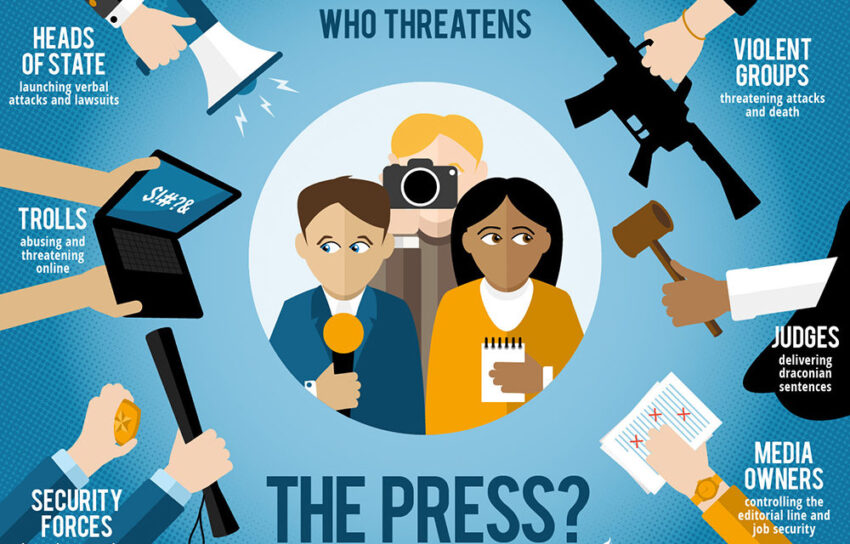
Most Americans See Financial, Political Influences
White and Asian Americans (78% each) are more likely than Hispanic (61%) and Black (60%) Americans to say press freedom is extremely or very important to society, Kirsten Eddy wrote Tuesday for the Pew Research Center.
Reporting on a survey pegged to World Press Freedom Day May 3, Eddy also said, “Half of White adults say press freedom should always be protected; 35% of Black adults say the same.”
Overall, a “large majority of Americans see the freedom of the press as highly important to the well-being of society. But many express concerns about potential restrictions on press freedoms in the United States – and say that political and financial interests already have a lot of influence on news organizations.”
Pew also reported, “Most U.S. adults (79%) believe the media are at least somewhat free to report the news in the country. However, only a third say they’re completely free to do so. About one-in-five Americans (21%) say the media are not very or not at all free to report the news in the U.S.
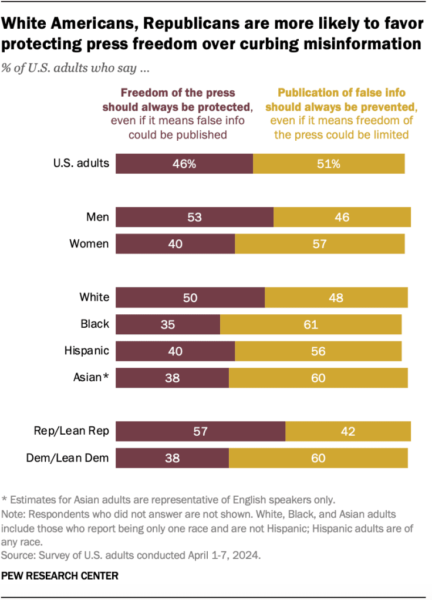
“At the same time, large majorities of Americans believe that U.S. news organizations are at least somewhat influenced by corporations and financial interests (84%) or by the government and political interests (83%). This includes about half of Americans who say news organizations are influenced a great deal by financial interests (51%) or by political interests (49%). . . .”
Pew did not offer any reason for the racial gap. “When it comes to our press freedom research, we have a lot more data on differences in views across age groups and political leanings. For example, when it comes to U.S. journalists’ concerns about press freedom,” said Sogand Afkari, a Pew communications manager.
But the survey also found, “U.S. adults with more formal education and higher income levels also are significantly more likely than those with less formal education and lower incomes” to say that press freedom should always be protected.
In addition, a September survey from Pew found “that 63% of Black Americans say news coverage about Black people is often more negative than news about other racial and ethnic groups.”
A report that same month from Nielsen, “Hispanic audiences in focus,” [PDF] found that, “When it comes to feeling represented in media, Latinos primarily find representation within dramas and feature films, highlighting a perceived lack of authentic Latino portrayals in many of television’s most-watched genres, including reality/variety, news and sports. This disparity illuminates an opportunity for greater, more authentic representation within these popular genres both on and off the screen.”
At a Journal-isms Roundtable in January on creeping authoritarianism. Charles Whitaker, dean of the Medill School of Journalism, Media, Integrated Marketing Communications, said, “We did a survey of Chicago area students aged 15 to 20 and found that over 70 percent of them said they do not watch any form or consume any form of news,” and that “their news diet has a very well-worn pattern of TikTok videos and things that are not necessarily related to civics and the functioning of the democracy.” Journalists should be asking, “How does one get through?” the dean said.
- American Press Institute: My’ media versus ‘the’ media: Trust in news depends on which news media you mean (2017)
- Benjamin F. Chavis Jr., DMin, National Newspaper Publishers Association: The California Journalism Preservation Act (CJPA) Will Hurt African American and Other Minority Owned Newspapers
- Sarah Naseer and Michael Lipka, Pew Research Center: How Hispanic Americans Get Their News (March 19)
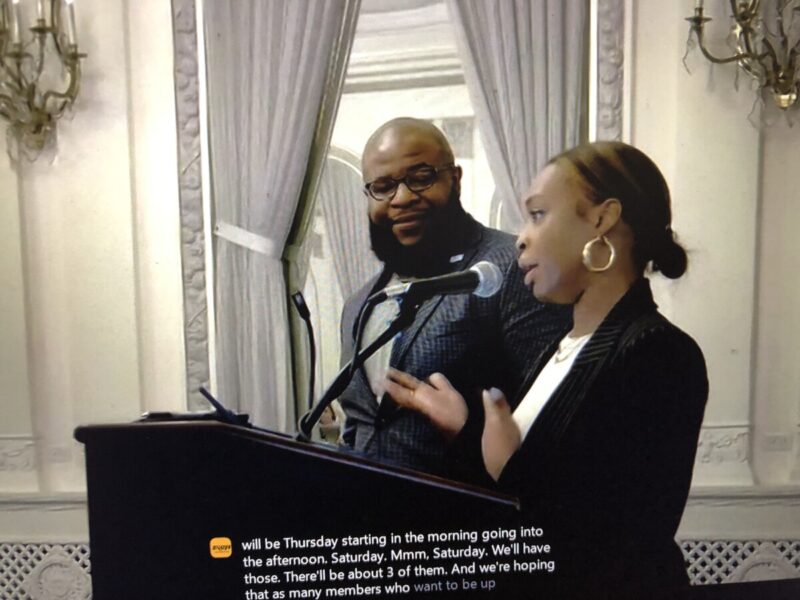
Brandon Pope, president of NABJ Chicago, and Raschanda Hall, president of the National Black Public Relations Society-Chicago Chapter, at the Hilton Chicago Saturday, describing for the NABJ board of directors what convention goers can expect in their city. The conference will overlap with the annual Lollapalooza music festival, to be staged downtown. Pope said the chapter hopes to raise $100,000 for its scholarship fund, for programming and for training for journalists. (Credit: Richard Prince)
NAHJ Going to Chicago After All — in 2025
The National Association of Hispanic Journalists, which pulled out of a planned joint convention in Chicago this year with the National Association of Black Journalists, will have its 2025 conference in the Windy City, NAHJ announced April 12.
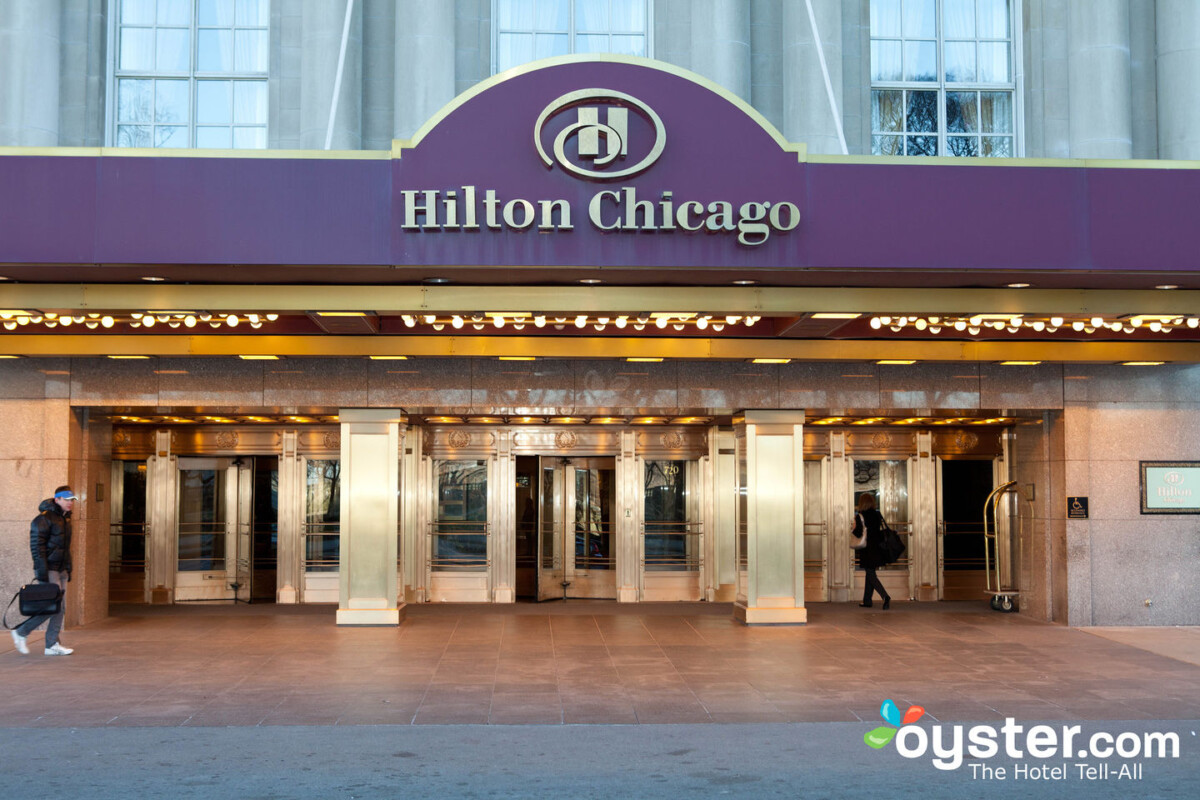 It is to be held July 6-15, 2025, at Hilton Chicago, where NABJ is meeting this coming July 31-Aug. 4.
It is to be held July 6-15, 2025, at Hilton Chicago, where NABJ is meeting this coming July 31-Aug. 4.
The release did not address the issue of penalties for its pullout.
NAHJ signed a contract to locate its 2024 convention in Hollywood even though an NAHJ agreement with a Chicago venue for 2024 was still in force, Drew Berry, executive director of NABJ, said last Aug. 2.
However, at NAHJ’s own board meeting Aug. 5, President Yvette Cabrera said, “We did not sign that initial contract with Chicago, and so the financial liabilities we believe will be minimal, and those are the things that we are discussing right now with the hotel.”
NAHJ Executive Director Yaneth Guillen-Diaz said in the release, “We’re really excited to follow our 2024 anniversary celebration in California by bringing the NAHJ conference to the Midwest in 2025. Chicago has some of the most vibrant Hispanic neighborhoods in the country, and it’s a central location for our members from across the U.S.”
Meanwhile, the NABJ board of directors met at the Hilton Chicago Friday for its spring meeting. Executive Director Berry said 1,390 people had registered for the convention, as of Thursday, far exceeding the 722 who had registered by April 30 for last year’s convention in Birmingham, Ala., and the 835 by April 30, 2019, for that year’s conference in Miami, NABJ’s largest ever.
Berry said there would be 111 sessions, eight meal events and 18 networking receptions, and that 137 booths had been sold for the career fair.
He added Saturday that NABJ membership is at 4,438, up from 4,279 in April 2023, with journalism students driving the growth, and that its finances are in excellent shape. It is under budget to the tune of $550,866, and its revenue is $985,620 higher than last year.
For the convention, Tia Mitchell, co-program chair, said NABJ had received 202 proposals for 72 workshop slots.
Asked Saturday about whether NABJ has been made whole now that NAHJ has agreed to convene at the Chicago Hilton in 2025 — Berry had said “We will not be left holding the bag” — Berry said, “When we have something to say about that, we will. There’s nothing we have to say about that at this point.”
New student chapters were approved for Bethune-Cookman University, Baylor University, Prairie View A&M University and the University of Texas. NABJ Sacramento became the newest professional chapter.
A photographer for KTBC-TV in Austin, Texas, was detained in the middle of a protest at the University of Texas at Austin on Wednesday. The photographer’s camera was livestreaming the time. (Credit: YouTube)
Campus Protests, Reactions Make Editorial Fodder
“Students at a growing number of U.S. colleges are gathering in protest encampments with a unified demand of their schools: Stop doing business with Israel — or any companies that support its ongoing war in Gaza,” Collin Binkley, Steve LeBlanc and Bianca Vázquez Toness reported Wednesday for the Associated Press.
Close beside them are both professional and student journalists, some caught up in police actions that have led to hundreds of arrests, and others producing news stories, editorials and commentary.
“A photojournalist with FOX 7 Austin was arrested during a pro-Palestinian protest at the University of Texas at Austin on Wednesday,” Robbie Farias reported Wednesday for the Austin (Texas) American-Statesman.
“Video footage posted on YouTube by FOX 7 Austin shows the photographer taking footage of the moment law enforcement began pushing back the protest line, resulting in the photographer being pushed into an officer. A Texas Department of Public Safety trooper pulled him backward before detaining him, according to FOX 7 Austin.”
The photographer identified himself as Carlos, and he was charged with criminal trespassing, KTBC (FOX 7) reporter Meredith Aldis said on X. She tweeted Thursday that he was released that morning.
The Society of Professional Journalists “demands that the Texas Department of Public Safety drop all charges against the photographer immediately,” the group said Thursday, calling it “a clear violation of the First Amendment.”
[April 29 update: SPJ President Ashanti Blaize-Hopkins tweeted: “This statement by @TxDPS is unacceptable. They drop the charges of trespassing against the @fox7austin photographer they arrested and now insinuate he hit a DPS Trooper (which he was NOT charged with). The videos are clear that the photographer did NOT hit anyone.
[Feels like retaliation and intimidation. To think this won’t have a chilling effect on other journalists covering instances of civil unrest would be very naive. . . .]
Columbia University’s Graduate School of Journalism tweeted Monday that the school “is committed to a free press. If you are a credentialed member of the media and have been denied access to campus, please send us a DM. We will facilitate access to campus.”
Yasmeen Altaji, a reporting fellow and M.A. candidate, added, “Hi, newsrooms: If you are relying on Columbia-affiliated journalists, namely student professionals in various programs at @columbiajourn, for exclusive, inside-campus coverage of protests and events, it is common (industry) courtesy and standard to compensate them for their work.”
Azmat Khan wrote with pride, “My @columbiajourn students are out reporting non-stop: working sources they’ve built over months, navigating the campus unlike any outsider, and adding much-needed context, humanity and depth to coverage.”
However, entrance to the protest space has not always been easy. On “Democracy Now!” student Jude Taha said Monday, “I have been speaking with multiple journalists who are coming in to cover the encampment, and increasingly it’s been harder and harder to try and get them in. . . . what I have also been seeing is people are believing that the facilitation through the journalism school means access to the encampment. And I would like to emphasize the encampment is not facilitating with the journalism school. It is an entity that is functioning on its own.”
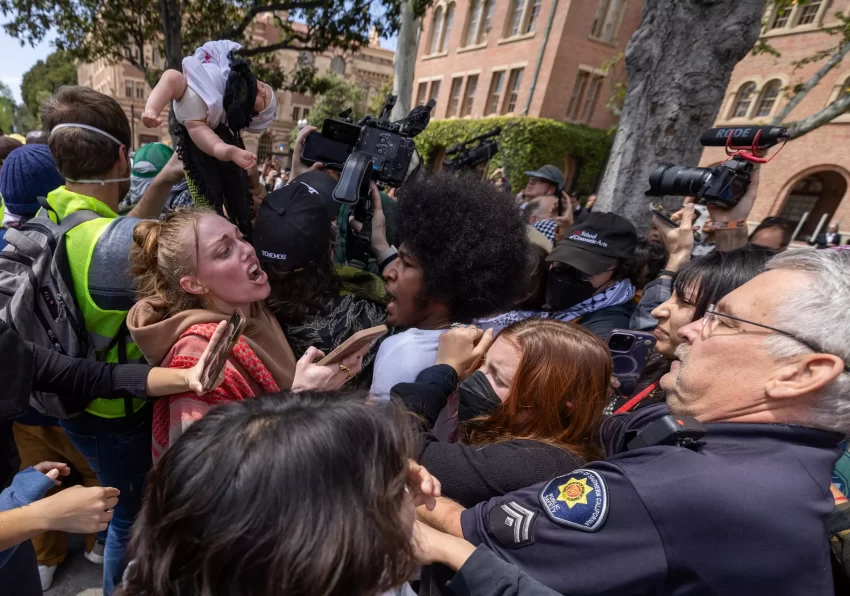
Officers and demonstrators clash at the University of Southern California Wednesday. (Credit: Brian van der Brug/Los Angeles Times)
Meanwhile, the student editorialists have gone to work. At the University of Southern California, the Daily Trojan objected to the school’s decision not to allow valedictorian Asna Tabassum to speak at commencement. The school cited safety concerns.
“As USC boasts of its Arab American Heritage Month celebrations, the decision to select a Muslim student as valedictorian should be a testament to the University’s commitment to equity,” the Daily Trojan editorialized. “But as soon as that student was found to have a view that was not palatable to some, the University’s efforts proved to be performative.”
At New York University, where police arrested 120 protesters at the “Gaza Solidarity Encampment,” the Washington Square News editorialized that “The administration’s response to the encampment revealed a university that is afraid of its students and faculty, not one that is listening to them.” It noted, “A WSN photographer documenting the event was also pepper-sprayed by a police officer, unprovoked.”
At Columbia University, an epicenter of the protests, the Spectator editorialized that “The administration has ignored our countless pleas to engage meaningfully with students, opting instead to continue down a path of surveillance, oppression, and authoritarian policies.”
Tom Jones of the Poynter Institute was one of several who zeroed in on the Spectator. Jones wrote Wednesday, “The work of college journalists on this story has been solid and responsible. The news stories have context. The editorials and columns seem well-reasoned. The coverage has been fair.”
In February, Boston’s Bay State Banner observed that the connection between African Americans and Palestinians has been complicated.
While the most vocal African Americans have been pro-Palestinian, there have not been the kind of protests at historically Black colleges and universities as on predominantly white campuses.
Nevertheless, The Hilltop at Howard University produced a story outlining the university’s policies toward protests. Lyric Hoover and Kathlyn Archibald-Drew reported that Dr. Cynthia Evers, vice president of Student Affairs, “said free speech zones, designated specific places on campus where students may exercise their rights to freely express themselves, are not imposed at Howard.
“ ‘Students may use their rights to free speech and expression anywhere on campus as long as they are complying with other University policies,’ she said. ‘Take the Yard (video) as an example of a place where our students, faculty and staff exercise their rights to freely express themselves.’ ”
As might be expected, the protesters and the campus papers have their critics. In November, the Times of Israel published a contribution from Gary Fouse, who worked from 1998 to 2016 as adjunct teacher at University of California at Irvine Extension, teaching English as a second language.
“The problem is that campus newspapers in general, in keeping with the times, try to maintain political correctness in dealing with controversial issues,” Fouse wrote. “At worst, they are overly sympathetic to the Palestinian side, often reporting that they cannot disclose the names of pro-Palestinian students whom they quote due to ‘threats against their personal safety’. Imagine that: The bully boys (and girls) of SJP [Students for Justice in Palestine} are afraid for their personal safety.
“To be clear and blunt: There can be no moral equivalence between Israel’s assault on Gaza in pursuit of Hamas and attempts to find their hostages with the horrific atrocities committed by Hamas on October 7. I have yet to find in any campus newspaper a detailed description of what those animals did. . . .”
- Corbin Bolies, Daily Beast: Columbia U. Newspaper Kids Working ‘Overtime’ to Get Protests Right
- Paul Butler, Washington Post: Columbia’s president is committed to one principle: Keeping her job
- Editorial, Harvard Crimson: The Encampment is Safe and Peaceful. Harvard Must Keep it That Way.
- Emmanuel Felton, Washington Post: Black college president says it’s time to fix Black-Jewish relations
- Stuart Gibson, letter to the editor, Daily Northwestern: Israelis Care More About Palestinian Lives than Hamas Does
- Angie Orellana Hernandez, Jaweed Kaleem and Melissa Gomez, Los Angeles Times: LAPD arrests 93 people at USC amid Israel-Hamas war protests
- Lamisa Khan, Washington Square News: Guest Essay: NYU chose bureaucracy over addressing pro-Palestinian student concerns
- Sanya Mansoor and Koh Ewe, Time: Pro-Palestinian Encampments Take Over American College Campuses
- William Melhado, Texas Tribune: Texas DPS could pursue criminal investigation into photojournalist arrested at UT-Austin protest
- Betsy Morais, Columbia Journalism Review: Spectator at the center
- Adrianna Nehme and Dharma Niles, Washington Square News: AAUP, SGA and GSOC release statements condemning NYU’s response to encampment
- Skye Seipp, Austin American-Statesman: DPS investigating arrest of FOX 7 photojournalist during pro-Palestinian protest at UT
- Prem Thakker, the Intercept: “Kill All Arabs”: The Feds Are Investigating UMass Amherst for Anti-Palestinian Bias
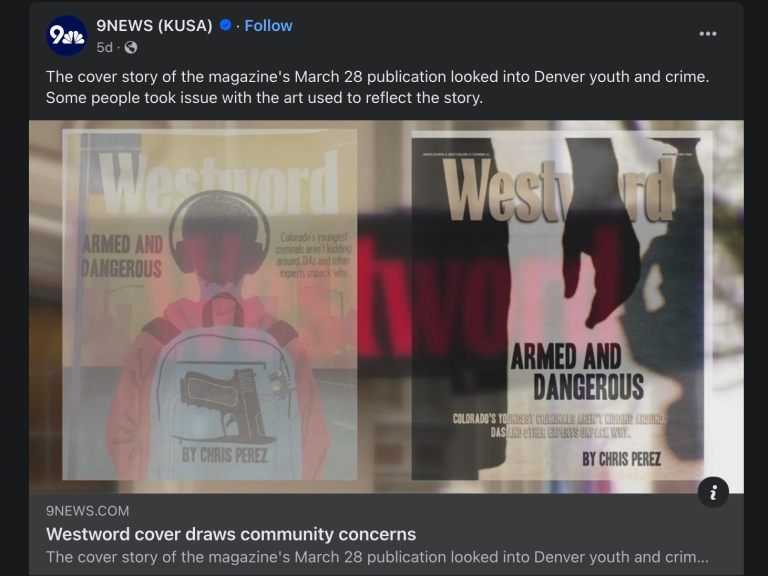
Denver Alt-Weekly Apologizes for Cover Image
Westword, an alternative Denver weekly, has apologized for using an image of a Black man on its cover to illustrate the rise in youth violence, adding that “We are also improving our internal systems by having more voices included in the approval process, to make sure that our covers (and all illustrations, for that matter) accurately and fairly depict the stories.”
 Separately, the publication The Trace announced The Gun Violence Data Hub,(logo pictured), “a new initiative by The Trace that aims to increase the accessibility and use of accurate data on gun violence. Its team of reporters, editors, and researchers will collect, clean, and publish datasets. The team will also proactively work with other newsrooms, assisting journalists in their pursuit of data-informed reporting on one of America’s most urgent public health crises.
Separately, the publication The Trace announced The Gun Violence Data Hub,(logo pictured), “a new initiative by The Trace that aims to increase the accessibility and use of accurate data on gun violence. Its team of reporters, editors, and researchers will collect, clean, and publish datasets. The team will also proactively work with other newsrooms, assisting journalists in their pursuit of data-informed reporting on one of America’s most urgent public health crises.
“The Data Hub, which will launch in fall 2024, will fill the gaps in the current data landscape, facilitate deeper reporting on gun violence, and increase public understanding of the issue.”
It continued, “Journalists, we want to hear from you. Tell us about the challenges you face in reporting on gun violence data. . . .”
Westword’s apology for the March 27 cover art came after complaints from Black readers, the Colorado Association of Black Journalists and, on Wednesday, the National Association of Black Journalists.
Letter writers Khalil Sellers and Raina Madrid of Denver included a list of 15 Black children they said were killed by law enforcement.
“All news and media organizations must hire and promote people who understand that imagery plays a major role in perception and perpetuating justifications for discrimination,” NABJ President Ken Lemon said in a statement.
“The imagery used on the Westword cover told a visual story that associates Colorado youths’ criminal activity with young Black males. This is not only dangerous and disturbing but also represents the types of actions that exemplify how misinformation and disinformation can be spread by irresponsible media portrayals. As a Black male, the cover hauntingly reminded me of how so many Black men and boys have lost their lives and have been harmed, falsely accused, and more because of perceptions based on imagery in the media.”

Al Tompkins wrote last year for the Poynter Institute, “I can only imagine the shivers running down the spines of bosses — who are already struggling to hire people — who have to send notices to staff saying they are free to go to the higher paying competition once their contracts expire. This could be the long overdue motivation that forces companies to pay their workers more.”
End of Noncompete Clauses Could Be Major
“Of all the professions, perhaps none is more commonly bound by contracts that define where else an employee can go work than local television news,” Lydia DePillis wrote a year ago in The New York Times.
“The restrictions, known as noncompete clauses, have been a condition of the job for reporters, anchors, sportscasters and meteorologists for decades. More recently, they’ve spread to off-air roles like producers and editors — positions that often pay just barely above the poverty line — and they keep employees from moving to other stations in the same market for up to a year after their contract ends.
“For that reason, there’s probably no industry that could change as much as a result of the Federal Trade Commission’s effort to severely limit noncompete clauses — if the proposed rule is not derailed before being finalized. Business trade associations are lobbying fiercely against it. . . .”
The rule was finalized Tuesday. The FTC “approved a rule to ban agreements commonly signed by workers not to join their employers’ rivals or launch competing businesses, which it says limit worker mobility and suppress wages,” as Daniel Wiessner reported for Reuters.
Many managers are not happy.
The U.S. Chamber of Commerce, the nation’s biggest business lobbying group, and the national tax-services firm Ryan LLC sued the Federal Trade Commission on Wednesday, “igniting a flare of lawsuits over the agency’s regulation aimed at ending noncompete agreements,” Dave Michaels reported for the Wall Street Journal.
Industry veteran Hank Price wrote for TV NewsCheck that if the decision stands, “it will be a kick in the teeth to television stations across the country. The decision also has the potential to lower anchor and reporter salaries, especially in larger markets. . . . Why pay huge salaries to a person who could move ‘across the street’ at any time?”
However, unions have applauded the FTC’s vote.
“Noncompete agreements trap workers from finding better jobs, drive down wages, and stifle competition,” the AFL-CIO, the country’s largest labor federation, said in a tweet in response to the announcement,” Reuters’ Wiessner reported.
“Left-leaning advocacy groups also praised the change, calling it a major victory for workers that will bolster the national economy by spurring entrepreneurship. ‘The FTC has abolished a modern form of involuntary servitude,’ said Sandeep Vaheesan, legal director of the Open Markets Institute, a think tank that focuses on antitrust issues.”
The noncompete rule affects far more than the media.
President Biden said in 2021:
“At least one in three businesses require their workers to sign a non-compete agreement. These aren’t just high-paid executives or scientists who hold secret formulas for Coca-Cola so Pepsi can’t get their hands on it. A recent study found one in five workers without a college education is subject to non-compete agreements. They’re construction workers, hotel workers, disproportionately women and women of color.
“Think of the 26-year-old employee at a company. She’s a star worker, but she isn’t being treated right. She’s underpaid, passed over for promotions. A competitor across the street knows and wants to bring her in at a higher wage, but she can’t do it. Her company threatens legal action over a non-compete clause she had to sign in order to get hired in the first place. She can’t afford a lawyer for help, so she’s locked in.”
- Winston Cho, Hollywood Reporter: A Ban on Noncompetes Could Raise Pay — and Complicate Contracts — in Hollywood
- Taylor Giorno, The Hill: What to know about the FTC ban on noncompete agreements
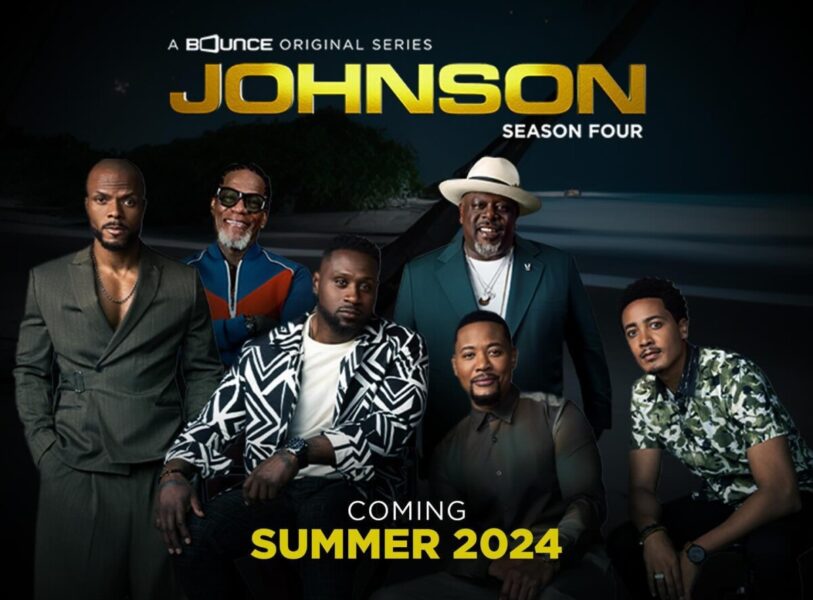
“Johnson” follows life-long best friends — all with the same last name of Johnson — as they navigate love, friendship, heartbreak and personal growth, as the Hollywood Reporter described it. Cedric the Entertainer is one of the producers.
Scripps Interested in Selling Bounce TV
“E.W. Scripps, one of the largest local TV broadcasters in the U.S., has hired a financial advisor to evaluate inbound interest in acquiring Bounce TV, its over-the-air network geared toward African Americans, according to Scripps CEO Adam Symson,” Alex Sherman reported Tuesday for CNBC.
Bounce was co-founded by civil rights leader Martin Luther King III, former Atlanta mayor and U.S. ambassador Andrew Young Jr., one-time Turner Broadcasting exec Ryan Glover and others. It was majority-owned and operated by African Americans, but was later sold to Scripps. It still calls itself “The first African-American broadcast TV network.”
Sherman also wrote, “Symson declined to comment on the names of the bidders or the potential price for Bounce TV. People familiar with the process said a deal could happen around mid-year or the third quarter. . . .
“Bounce TV, which debuted in 2011, is a free over-the-air network that broadcasts a combination of syndicated shows, movies and original content. All content is geared to African American audiences. Bounce TV’s ‘Johnson,’ a dramedy created by Deji LaRay, is entering its fourth season. The network is also launching a new comedy series, ‘Mind Your Business,’ that premieres June 1.
“Ratings for Bounce TV have improved in recent years, even as legacy media has struggled. In the first quarter, Bounce TV viewership was up 14% on linear and 9% on connected TVs, Symson said. About 70% of Bounce TV’s audience is over the air. The other 30% is derived through pay TV and streaming, he said.”
Michael P. Hill added for Newscast Studio, “Bounce became part of Scripps in 2017 when it [bought] Kat Networks for over $300 million. In an interview on CNBC, Scripps CEO Adam Symson described the company as being proud of its ‘stewardship’ of the Bounce brand.
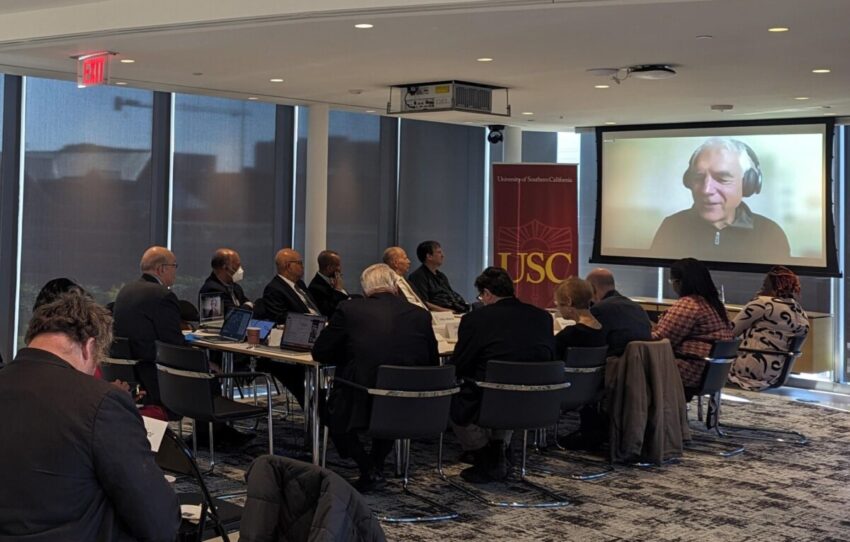
Guy Berger, recently retired as director for freedom of expression and media development at UNESCO, speaks to the Africa-U.S. Forum via Zoom. “If we want truth, we’ve got to link it to the concept of information in the public good,” he said. (Credit: Jung – Hwa Kang/USC)
Outsiders, Leaders Stoke Africa’s Media Crises
From crumbling business models to the rise of authoritarianism and the trolling of female journalists online, Africa has all the ailments vexing Western media, with the added challenges of incursions by Russia and China — no believers in a free press — and a population where effective media literacy has yet to take hold.
That was the consensus of the “Africa-U.S. Forum: Africa and Freedom of Expression,” held Monday in Washington and by Zoom, with participants from the continent.
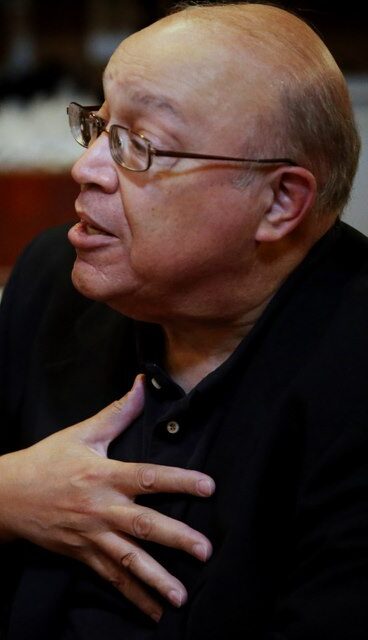 Led by Adam Clayton Powell III (pictured, by Sharon Farmer) in advance of World Press Freedom Day May 3, the two-hour session was sponsored by USC Annenberg Center on Communications Leadership & Policy, where Powell is executive director of the USC Election Security Initiative, the Institute for African Studies at George Washington University and the Center for African Studies at Howard University.
Led by Adam Clayton Powell III (pictured, by Sharon Farmer) in advance of World Press Freedom Day May 3, the two-hour session was sponsored by USC Annenberg Center on Communications Leadership & Policy, where Powell is executive director of the USC Election Security Initiative, the Institute for African Studies at George Washington University and the Center for African Studies at Howard University.
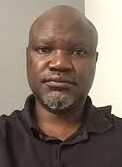 “Not everyone seems to want critical journalism,” said Churchill Otieno (pictured), president of the African Editors Forum, in perhaps an understatement. Those who do are often branded “enemies.”
“Not everyone seems to want critical journalism,” said Churchill Otieno (pictured), president of the African Editors Forum, in perhaps an understatement. Those who do are often branded “enemies.”
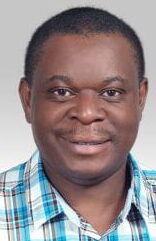 When some governments want to “preserve public order,” such as in Uganda, Zimbabwe and Senegal, said Bob Wekesa (pictured), they shut down the internet. Wekesa is director and co-founder of the African Center for the Study of the United States and the Inaugural Africa Fellow at the USC Annenberg Center for Communication Leadership and Policy.
When some governments want to “preserve public order,” such as in Uganda, Zimbabwe and Senegal, said Bob Wekesa (pictured), they shut down the internet. Wekesa is director and co-founder of the African Center for the Study of the United States and the Inaugural Africa Fellow at the USC Annenberg Center for Communication Leadership and Policy.
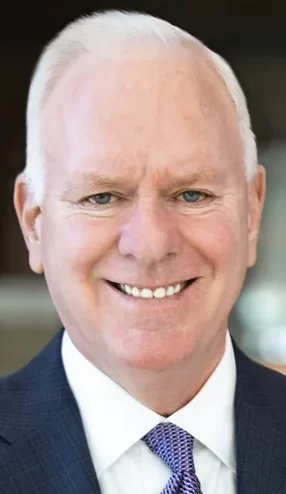 John Lansing (pictured), who for four years was president and CEO of NPR, urged attendees to read Peter Pomerantsev’s 2014 book, “Nothing Is True and Everything Is Possible: The Surreal
John Lansing (pictured), who for four years was president and CEO of NPR, urged attendees to read Peter Pomerantsev’s 2014 book, “Nothing Is True and Everything Is Possible: The Surreal
Heart of the New Russia.”
“Pomerantsev, a British journalist of Russian heritage, began going to Russia regularly as a reality television producer almost a decade ago, and it’s through that prism that he sees the country,“ Miriam Elder summarized in The New York Times. “ ‘Reality’ is scripted by the dark forces inside the Kremlin. Fake opposition parties engage in fake opposition to those who rule, a fake justice system goes through the motions of the legal process, and the fake television news shapes what Russia’s 143 million citizens are allowed to see.”
That’s the threat facing citizens worldwide, Lansing said, the persistent creation of alternate realities, or “alternative facts,” as Donald Trump aide Kellyanne Conway famously put it in 2017.
At least four African countries are “going the Russian way”: Mali, Burkina Faso, Niger and Central African Republic, Wakesa said.
And as has been well-documented, China continues to make inroads.
Wekesa is author of “China’s Footprint in East Africa: Pessimism versus Optimism.”
He told the group that many broadcasters use Chinese engineers and that the country lays fiber optics for internet connections, leading to “data harvesting.”
The African Center for Strategic Studies summarized Wekesa’s book this way:
“Chinese disinformation practices in Africa are not new and until recently have been explicitly described by the Chinese government as propaganda campaigns, according to leading media scholar Dr. Bob Wekesa with the University of Witwatersrand in South Africa. Speaking from his experiences working in Kenyan media houses and researching Chinese media, Dr. Wekesa defines China’s approach to the media sector as the ‘total state control of information.’ This conceptualization views information as capital to be exploited by the state rather than a public good grounded in journalistic standards.
“Dr. Wekesa explains that in contrast to other external actors who have sponsored disinformation campaigns in Africa, China has pursued a more institutionalized approach in exporting its media practices to Africa. One route is by training African journalists and editors in Chinese programs that coach the avoidance of criticizing African presidents and ministries as well as Chinese officials. Another route is by purchasing ownership shares in African media houses and nudging their editorial practices toward the Chinese model. A third is through the sale of Chinese technology to Africa that allows governments to more closely control digital information, including by blocking sites and shutting down internet access.
“Dr. Wekesa relates how many African media professionals seek to preserve their independence and journalistic standards as watchdogs of state officials, leading them to push back on Chinese influence in African media. He recommends that African media professionals continue to seek out educational opportunities to understand changing digital media ecosystems and form partnerships with journalistic enterprises of similar standards. . . .”

Conference, sponsored by AllAfrica Global Media, is scheduled for Nairobi next month.
The most pressing issue for African media was judged to be financial. “The No. 1 thing is to figure out the next revenue model,” said Lansing.
As the International Federation of Journalists reported this week, “The South African online news website, The Daily Maverick, which also runs a weekly newspaper, closed down its operations on 15 April for 24 hours to protest against dominance of big tech companies and the global crisis that journalism faces. The International Federation of Journalists (IFJ) adds its voice to the call of The Daily Maverick urging Internet giants that do not produce any form of news content to financially compensate journalists and media outlets whose articles are used by the tech corporations.
“With its action, The Daily Maverick warns against the devastating effects of ongoing business models of tech giants, which make benefits by distributing words, images and sounds that media professionals have authored and performed. . . “
Contributing to the financial crisis, said Otieno, leading the African editors group, is that journalists are promoted to top positions based on their journalistic cred, not their business acumen. The editor needs to be able to manage budgets and revenue, he said. Other problems: “Media does not cover media,” and governments withdrawing advertising dollars from publications they dislike, resulting in self-censorship at outlets where such money can be 50 percent of revenue.
That’s not to mention the potential impact of artificial intelligence and ChatGPT, Wekesa added. The generative AI-created fake nude images of Taylor Swift that flooded the internet this year — called “deepfakes” — did not go unnoticed.
For International Women’s Day last month, the Media Institute of Southern Africa offered a resolution that “highlights and laments that, digital violence is increasingly gendered and disproportionately affects women,” through among other things, “threats of sexual violence, misogynistic disinformation campaigns and revenge pornography.”
The conversation is to continue in many venues. As Wekesa said, “The idea of media literacy hasn’t taken hold the way it should. There has to be work and investment in helping citizens understand . . . .”
AllAfrica Global Media, for one, is launching a new convening platform: the AllAfrica Media Leaders’ Summit, to be held May 8-10 in Nairobi, under the theme “Re-engineering African Media in Times of Critical Transformation”.
- Addis Standard, Ethiopia: News Analysis: Ethiopia’s online boom shadowed by rise in hate speech, new report labels threat as ‘high and dangerous’
- African Digital Democracy Observatory, Medium: How African news media can prevent misinformation (Aug 29, 2022)
- Melody Chironda, allAfrica.com: South Africa: Will South Africa’s Voters Survive the Disinformation Deluge?
- Collaboration on International ICT Policy for East and Southern Africa: New Report: Disinformation Pathways and Effects on Democracy and Human Rights in Africa (May 2022)
- Committee to Protect Journalists: Prosecutor requests 15-month sentence for jailed DRC journalist Blaise Mabala
- Committee to Protect Journalists: Tunisian journalist Mohamed Boughaleb sentenced to 6 months in prison for defamation (April 18)
- Committee to Protect Journalists: Zambian police detain 2 journalists, make them delete interviews with opposition
- Ghanaian Times: 30% [of] media outlets collapse due to financial constraints – Minister (April 19)
- The Point, Gambia: Newspaper publishers meet President Barrow
- Abbas Jimoh, Daily Trust, Nigeria: Editor’s Detention: NPAN, BON, CSOs Approach Ombudsman
- Getachew Minas, Ethiopian Herald: Control Hate Speech, keep away consequences
KHOU-TV in Hawaii explains the FCC vote. (Credit: YouTube)
FCC Reinstates Net Neutrality, but . . .
“The Federal Communications Commission on Thursday voted to reinstate rules repealed in 2017 that would prevent internet service providers from disrupting your internet speed,” Betty Lin-Fisher and Amritpal Kaur Sandhu-Longoria reported Thursday, updated Friday, for USA Today.
“The 3-2 vote along political party lines restores net neutrality – a policy that ensures your internet service provider doesn’t block or slow legal traffic, or charge more to deliver some content more quickly . . . .”
Press freedom advocates have long backed “net neutrality,” with the National Association of Hispanic Journalists one of the stalwarts. “NAHJ has been the leading voice in journalism supporting Net Neutrality over the past decade,” the organization declared in 2015.
But The Washington Post wrote Wednesday that the issue is no longer the same as it once was. “The internet has changed dramatically since the early 2000s, when the idea of internet service providers having to treat all data equally first became popular. Two major changes since then include the shift from personal computers to mobile devices and the growing number of items connected to the internet, from robot vacuum cleaners to entire factories,” Eva Dou reported.
“As the internet has proliferated, the question of precisely where it begins and ends has become murkier. Now some mobile executives are arguing that an emerging 5G technology called ‘network slicing’ should be considered to lie in the hazy realm beyond the internet’s borders, unconstrained by net neutrality. . . .”
Still, the National Hispanic Media Coalition, if not NAHJ, celebrated the FCC decision.
“Today the FCC reinstates three bright line rules: no blocking, no throttling, and no paid prioritization,” Brenda Victoria Castillo, president and CEO, said in a statement Thursday.
“NHMC remains a vigorous supporter of those three bright line rules, largely because we have seen first-hand the need for specific protections. Those in opposition to these rules claim that they are unnecessary to protect consumers. However, the most readily available data tells a different story.
“In 2017, NHMC filed a Freedom of Information Act Request (FOIA Request) requesting consumer complaints under the 2015 Open Internet Order, with responses from the ombudsperson and carriers, to shed light on the critical value of the Net Neutrality protections that the FCC is working to reinstate. After a long battle with the Trump-era FCC, more than 47,000 consumer complaints were released to NHMC, with over 68,000 pages of consumer complaint documents alone. . . . “
Migrants, People of Color Figure in New Poynter Honors
“Poynter announced Tuesday the winners of its inaugural journalism contest, continuing a tradition that was most recently headed by the News Leaders Association,” Angela Fu reported Tuesday for the Poynter Institute.
“Poynter hosted the prizes for the first time this year after the NLA decided last year to transfer its awards program to the Institute. The NLA, a nonprofit organization dedicated to newsroom leadership, diversity and First Amendment issues, had run a journalism contest since 2019. But financial challenges forced the association’s board to vote in October to dissolve the organization and transfer its assets — including the NLA Awards — to other nonprofit journalism groups.”
Among the winners:
- The Dori J. Maynard Justice Award: “Awarded to Nicole Dungca, Claire Healy and Andrew Ba Tran of The Washington Post for The Collection, an investigation into the Smithsonian’s collection of human remains, many of which belonged to Black and Indigenous people. The award honors social justice reporting.”
- The Deborah Howell Award for Writing Excellence: ” Megan Cassidy and Gabrielle Lurie of the San Francisco Chronicle for an 18-month investigation that explored how migrants from Honduras’s Siria Valley provide the labor that fuels San Francisco’s drug crisis. The award recognizes distinguished achievement in writing in any medium.
- The Burl Osborne Editorial and Opinion Award: “the San Antonio Express-News for Political crisis at the border, a series that looks at how barbed wire is a cruel and ineffective tactic to keep people from entering the U.S. The award recognizes excellence in editorial writing that has made an impact on behalf of a community, resulting in change for the better.
- The Robert G. McGruder Diversity Award: the Mississippi Free Press for building its newsroom with community and its diversity in mind. The award honors the accomplishments of media professionals who encourage diversity in hiring and coverage.”
- The top prize, The Batten Medal, went to “Casey Ross and Bob Herman of Stat for Denied by AI: Consequences for Sick and Vulnerable Americans, a series of stories about the use of algorithms to deny care to ill patients in pursuit of higher profits. The medal recognizes exceptional journalism that makes a difference to the lives of people and their communities.”
Short Takes
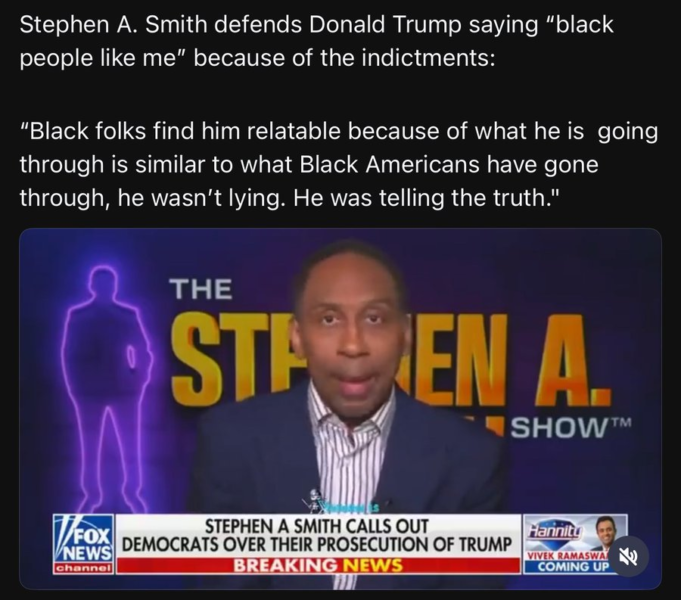
- “Stephen A. Smith has apologized for remarks last week suggesting that Trump was receiving support from the Black community because we relate to his legal woes,” Keith Boykin wrote Tuesday for Word In Black. ” ‘A lot of folks in Black America seem pretty pissed at me right now,’ said the controversial ESPN host. ‘For that, I sincerely apologize.‘ But it wasn’t really an apology. . . .” Bakari Sellers weighs in
- “The decadeslong struggle of local media is getting a lifeline in New York,” Joseph Spector reported Sunday for Politico. “The state budget, set to be finalized Saturday, includes the nation’s first payroll tax credit for local news organizations in a bid to encourage new hiring amid the ongoing struggles of journalism outlets to cover their communities. Lawmakers and independent media companies praised the tax break, which will designate $30 million a year to the program, called the Local Journalism Sustainability Act. . . .”
- “
 Alfonso Chardy (pictured), a Miami Herald journalist who anchored Pulitzer Prize-winning reporting that helped expose the Iran-contra affair, a covert and illegal Reagan administration network to aid rebels in Nicaragua that later led to riveting hearings in Congress, died April 9 at a hospital in Miami. He was 72,” Brian Murphy reported April 13 for The Washington Post. “Alfonso Nieto Chardi was born on April 14, 1951, in Mexico City. . . . He learned English through courses and listening to the radio. He served in the army for six months and then worked as a proofreader and translator at the English-language Mexico City News, where an editor once rendered his name as Chardy. He credited the student protests in Mexico in 1968 and the Mexico City Olympics that year for his interest in journalism as he watched foreign reporters pour into the Mexican capital. . . .”
Alfonso Chardy (pictured), a Miami Herald journalist who anchored Pulitzer Prize-winning reporting that helped expose the Iran-contra affair, a covert and illegal Reagan administration network to aid rebels in Nicaragua that later led to riveting hearings in Congress, died April 9 at a hospital in Miami. He was 72,” Brian Murphy reported April 13 for The Washington Post. “Alfonso Nieto Chardi was born on April 14, 1951, in Mexico City. . . . He learned English through courses and listening to the radio. He served in the army for six months and then worked as a proofreader and translator at the English-language Mexico City News, where an editor once rendered his name as Chardy. He credited the student protests in Mexico in 1968 and the Mexico City Olympics that year for his interest in journalism as he watched foreign reporters pour into the Mexican capital. . . .”
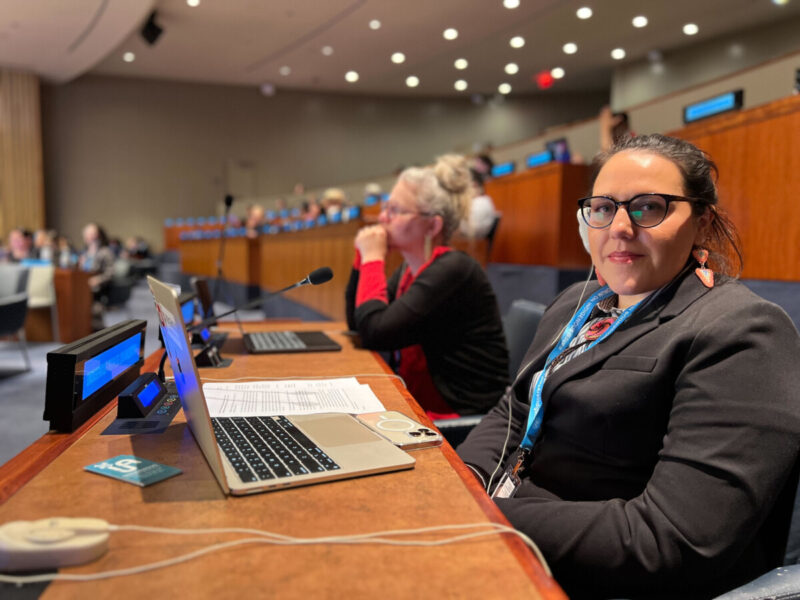
- “Christine Trudeau, Prairie Band Potawatomi Nation, president of the Indigenous Journalists Association, delivered an intervention today at the United Nations Headquarters in New York City during the 23rd session of the United Nations Permanent Forum on Indigenous Issues,” the association reported Monday. “Globally, Indigenous communities are ignored, misrepresented, maligned, and in many cases dehumanized by media portrayals of our cultures, distinct issues, and the challenges we face due to the impacts of colonization,” said Trudeau. “This is often because our communities are either not represented in newsrooms, or do not have access to Indigenous-led media.”
- “Press Forward, the $500 million movement to reimagine local news, will launch applications on April 30 for its first open call for funding focused on addressing the long-standing inequalities in journalistic coverage of underserved communities,” the organization announced Monday. “Local news outlets that fill coverage gaps with original reporting – and have a budget under $1 million – will be eligible to apply for Press Forward funding. The Press Forward Open Call on Closing Local Coverage Gaps will provide 100-plus news outlets with an expected $100,000 each in funding, whether they are non-profit or for-profit entities. . . .”
- “NPR’s leaders redoubled their efforts to diversify their audience and work force and closely tracked metrics for each,” Benjamin Mullin and Jeremy W. Peters reported Wednesday for The New York Times. “So it came as a disappointment to some people on NPR’s board last fall when they were presented new internal data showing . . . Black listeners made up roughly 11 percent of NPR’s audience in the second quarter of 2023, unchanged from roughly 11 percent from the same period in 2020, according to the data. The data further showed that the share of Hispanic listeners went up by only 2 percentage points since 2020, to account for 16 percent of the total audience. One 2020 survey, from the Pew Research Center, found that of the people who named NPR as their main source for political and election news, 75 percent were white, more than any other outlet except Fox News. . . .”
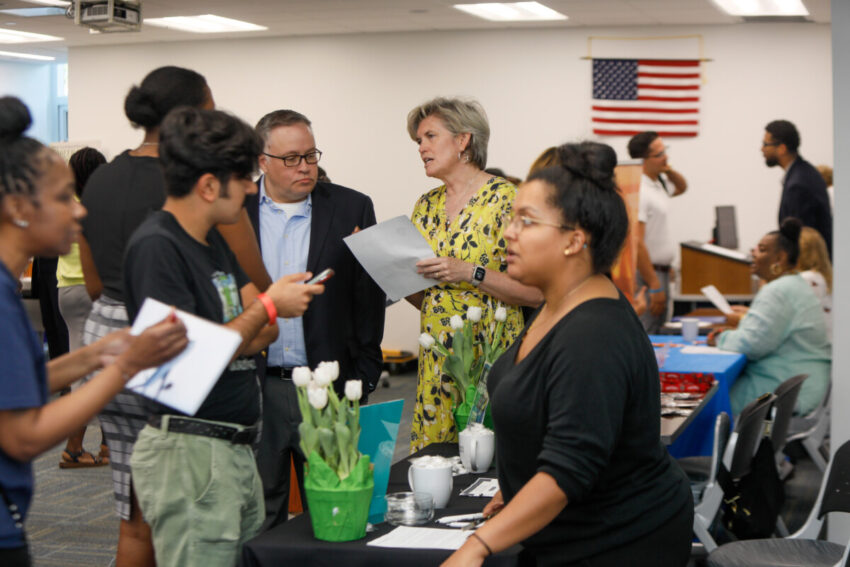
An attendee speaks with Abeba Asseged, a news producer at Miami’s WFOR-TV. In the background, Kimberly Voet, WFOR president and general manager, speaks with Miguel Fernandez, vice president and news director. (Credit: Alexia Fodere)
- More than 100 people — “aspiring young journalists, college students and professionals” — attended the joint career fair staged by the National Association of Black Journalists (NABJ) South Florida Chapter, partnering with the National Association of Hispanic Journalists (NAHJ) South Florida Chapter on April 20, NABJ chapter president Calvin Hughes told Journal-isms. “We had an incredible turnout. It was one of our most successful career fairs. We had more than a dozen vendors including each local TV station affiliate. . . . Our title sponsors were FIU [Florida International University] and Delta” Air Lines.
- “The annual Career Expo at Columbia Journalism School concluded on Saturday, March 23, 2024, with nearly 140 news media companies in attendance online, making it the biggest journalism job fair in the United States,” the school announced April 3. “Columbia welcomed more than 200 editors, producers and hiring managers from news companies across the New York metro region, the U.S., and the globe. . . .”
- In Pennsylvania, “A First Amendment lawsuit brought by journalist Brittany Hailer has forced Allegheny County to revise policies that previously barred its jail employees and contractors from speaking publicly and with members of the news media about matters of public concern without permission, changes that could result in more accountability reporting about the Allegheny County Jail,” the Reporters Committee for Freedom of the Press said Wednesday.
 To bolster their workforces after the COVID-19 pandemic created an unprecedented staffing crisis for hospitals in the United States and Europe, hospitals have dramatically accelerated hiring from countries such as the Philippines, India, Nigeria, Zimbabwe, and Jamaica, the Sidney Hillman Foundation said. “They have long sent trained, experienced nurses to work abroad, but since the start of the pandemic, the exodus that was a steady trickle has become a flood.” Aurora Almendral (pictured), an international editor at NBC News, based in London, “traveled to India, Nigeria, the Philippines, the United Kingdom, and across the United States to investigate the consequences of this global trend. She revealed an international bidding war for healthcare workers, leading to the rampant exploitation of migrant nurses. It leaves poorer health systems around the world scrambling to cope,” the foundation said, honoring Almendral with its award for “Reporting on Racial and Economic Justice.”
To bolster their workforces after the COVID-19 pandemic created an unprecedented staffing crisis for hospitals in the United States and Europe, hospitals have dramatically accelerated hiring from countries such as the Philippines, India, Nigeria, Zimbabwe, and Jamaica, the Sidney Hillman Foundation said. “They have long sent trained, experienced nurses to work abroad, but since the start of the pandemic, the exodus that was a steady trickle has become a flood.” Aurora Almendral (pictured), an international editor at NBC News, based in London, “traveled to India, Nigeria, the Philippines, the United Kingdom, and across the United States to investigate the consequences of this global trend. She revealed an international bidding war for healthcare workers, leading to the rampant exploitation of migrant nurses. It leaves poorer health systems around the world scrambling to cope,” the foundation said, honoring Almendral with its award for “Reporting on Racial and Economic Justice.”
- “Over the past decade, Flint’s water crisis has revealed how government failures at every level could effectively kill a city while opening the country’s eyes to how an environmental crisis could wreak havoc on all facets of life, make people sick, destroy a public school system, and kill jobs,” Adam Mahoney wrote Tuesday for Capital B. “Four years after Flint residents reached the largest civil settlement agreement in Michigan history,” tens of thousands of victims “still haven’t received a penny from the $626.25 million pot. The only money doled out has gone to lawyers involved in the case, not those who’ve been haunted by the crisis’s true impacts. Still, even when residents ultimately receive the funding, most expressed doubts that the payouts will have any true benefits for their life. . . . “
- “A beloved member of the KSAT team has died,” the San Antonio television station reported Sunday, updated Monday. “Photojournalist Jose ‘Joe’ Arredondo, 49, died in his sleep just hours before he was scheduled for his Saturday morning shift. ‘Joe was a beloved and energetic journalist who always had a smile,’ said KSAT News Director Mario Orellana. ‘He had been with KSAT since 2019 and was someone we depended on for the big stories and events. Joe’s creativity, hustle, and kindness will be missed throughout the building.’. . . ”
 “Mario Parker (pictured) will become Bloomberg News managing editor of economy/government overseeing coverage of the 2024 election, White House, Congress, and international economics and security, Washington bureau chief Margaret Collins announced Tuesday,” Chris Roush reported for Talking Biz News. “Parker was previously White House and politics editor since January 2023, helping Bloomberg News both prepare and cover the Republican presidential primary as well as President Joe Biden’s re-election bid. . . .”
“Mario Parker (pictured) will become Bloomberg News managing editor of economy/government overseeing coverage of the 2024 election, White House, Congress, and international economics and security, Washington bureau chief Margaret Collins announced Tuesday,” Chris Roush reported for Talking Biz News. “Parker was previously White House and politics editor since January 2023, helping Bloomberg News both prepare and cover the Republican presidential primary as well as President Joe Biden’s re-election bid. . . .”
- Daniel G. Alarcón, National Public Radio and Columbia Journalism School; Raney Aronson-Rath, Frontline, Public Broadcasting Service; Jamelle Bouie, The New York Times; Carlos Lozada, The New York Times; former Los Angeles Times editor Kevin Merida and Rachel L. Swarns of New York University and The New York Times have been elected to the American Academy of Arts and Sciences. “Founded in 1780, the American Academy of Arts and Sciences honors excellence and convenes leaders from every field of human endeavor to examine new ideas, address issues of importance to the nation and the world, and work together ‘to cultivate every art and science which may tend to advance the interest, honor, dignity, and happiness of a free, independent, and virtuous people,’ ” the organization says.
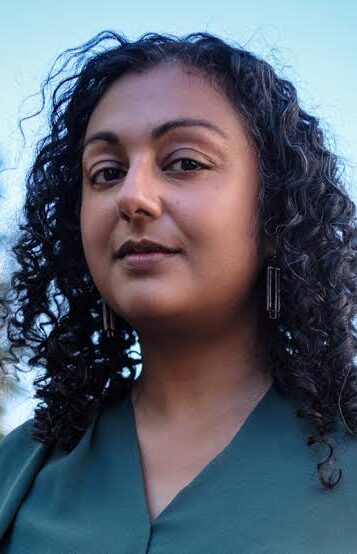 Tasneem Raja (pictured), editor-in-chief of California’s The Oaklandside, and co-founder of nonprofit news organization Cityside Journalism Initiative, which publishes Oaklandside, Berkeleyside, and Richmondside, has won the International Women’s Media Foundation’s 2024 Gwen Ifill Award, “recognizing her career-long commitment to advancing equitable news spaces and cultivating diverse journalistic talent. With close to 20 years of experience as a data journalist and news editor, as well as co-founding multiple outlets and non-profit newsrooms, Raja has built an exemplary model of community-centered journalism,” the foundation said Wednesday.
Tasneem Raja (pictured), editor-in-chief of California’s The Oaklandside, and co-founder of nonprofit news organization Cityside Journalism Initiative, which publishes Oaklandside, Berkeleyside, and Richmondside, has won the International Women’s Media Foundation’s 2024 Gwen Ifill Award, “recognizing her career-long commitment to advancing equitable news spaces and cultivating diverse journalistic talent. With close to 20 years of experience as a data journalist and news editor, as well as co-founding multiple outlets and non-profit newsrooms, Raja has built an exemplary model of community-centered journalism,” the foundation said Wednesday.
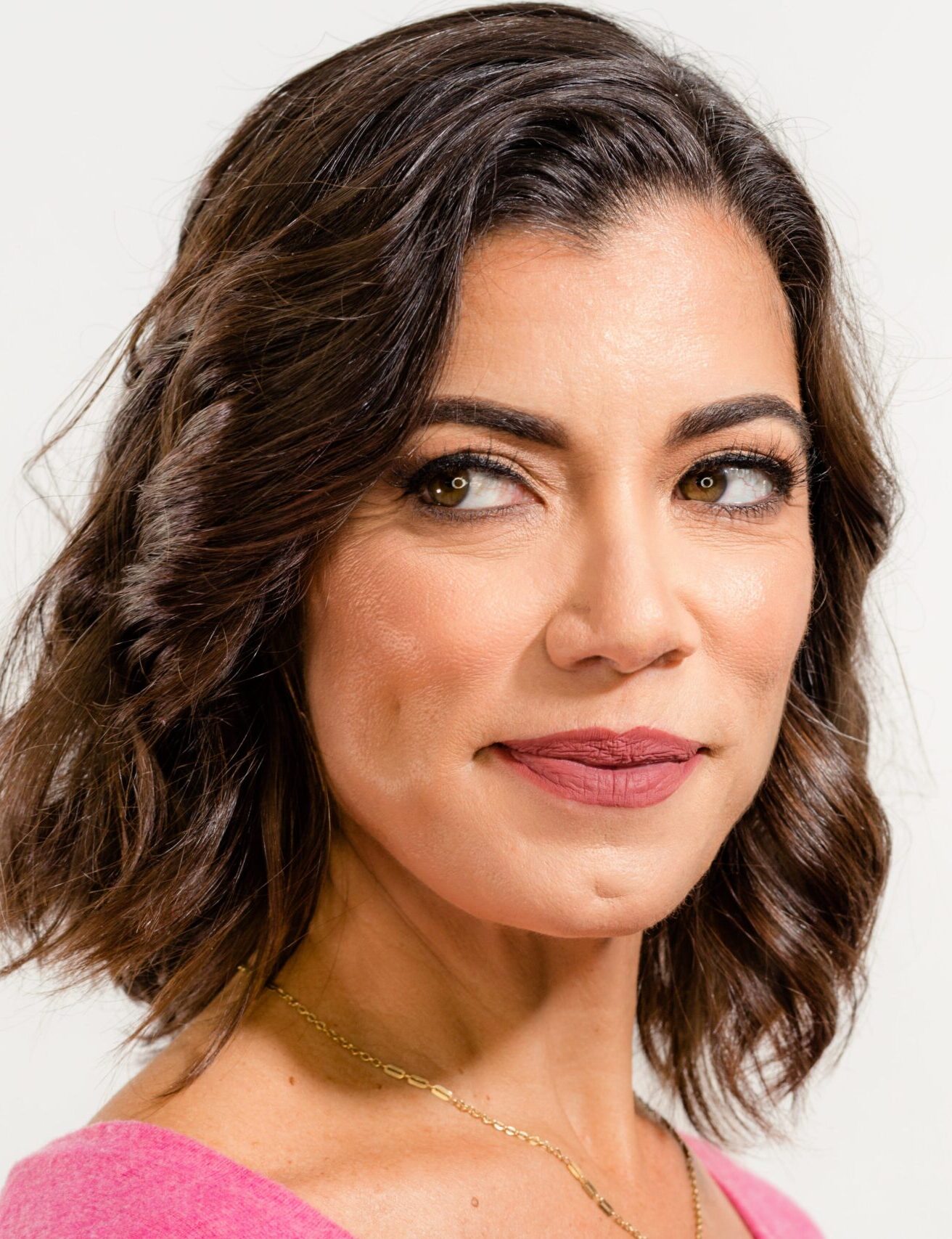 Fernanda Santos (pictured) is joining The 19th as managing editor to “help shape our coverage during this crucial election year and beyond,” Zurii Conroy, people operations manager, announced Friday. “Fernanda has spent her career elevating the stories of underrepresented and misrepresented communities, working as a staff writer for The New York Times, contributing columnist for The Washington Post, editorial director at Futuro Media and professor at the Walter Cronkite School of Journalism and Mass Communication at Arizona State University. . . .”
Fernanda Santos (pictured) is joining The 19th as managing editor to “help shape our coverage during this crucial election year and beyond,” Zurii Conroy, people operations manager, announced Friday. “Fernanda has spent her career elevating the stories of underrepresented and misrepresented communities, working as a staff writer for The New York Times, contributing columnist for The Washington Post, editorial director at Futuro Media and professor at the Walter Cronkite School of Journalism and Mass Communication at Arizona State University. . . .”
- “With Port-au-Prince hemmed in by the uprising, and foreign journalists struggling to arrive, it has fallen to a gutsy fellowship of Haitian reporters to get the word out about the city’s drama,” Tom Phillips and Etienne Côté-Paluck wrote April 16 for The Guardian. “Just as Palestinian journalists have kept the world informed about the war in Gaza, a place where foreign reporters are almost entirely banned from entering, so too are Haitian correspondents playing a vital role in documenting their city’s state of siege. . . .”
- “Independent journalist Camila Acosta, a regular contributor to CubaNet and the Spanish newspaper ABC, denounced a police surveillance operation against her in front of the property where she resides,” CubaNet reported from Miami. “Acosta confirmed that it is a post set up by the political police and that it has been operating intermittently for several months. . . . ” ‘What is happening in Cuba that they want to prevent me from leaving the house? But nothing. It seems like it’s routine, so as not to lose the habit, and to remind me that, even if they don’t knock on my door or summon me, they are always there. “This is how those of us who dare to denounce the dictatorship live in Cuba,” said the journalist. . . .’ “
- “At least 253 Nicaraguan journalists have left their country since April 2018 for security reasons — or suffered banishment — by the government of Daniel Ortega, according to a report released Sunday (April 21) by the Costa Rica-based NGO Colectivo de Derechos Humanos Nicaragua Nunca Más (Nicaragua Never Again Human Rights Collective),” Deutsche Welle reported Monday.
- ” An Australian journalist with the country’s public broadcaster was pressured to leave India after Indian authorities expressed anger over her reporting on Sikh separatism and informed her that her journalist visa would not be renewed, the Australian Broadcasting Corporation and the journalist, ABC South Asia bureau chief Avani Dias, said Tuesday,” Gerry Shih reported Tuesday for The Washington Post.
- “One of Argentina’s most popular journalists sued President Javier Milei for the crime of libel after the president accused him of being a liar and extortioner for his criticism of the Israeli ambassador’s participation in a cabinet conclave,” the Associated Press reported April 19. “Jorge Lanata, founder of a newspaper, author of several books and currently host of one of the most listened to current affairs radio programs in the country, filed through his lawyers a criminal lawsuit for libel and another civil lawsuit for reparation against Milei this Thursday in the Buenos Aires courts, the journalist himself confirmed. . . .” Interview
- “The journalistic environment of Santa Cruz, [Argentina], especially its capital Río Gallegos, felt a strong shock today [April 17] after it was reported that journalist Huyo Moyano, recognized for the Contracara program of the station Radio News, received an envelope with two bullets inside as a death threat,” La Tecla Patagonia reported, according to LatAm Journalism Review.
To subscribe at no cost, please send an email to journal-isms+subscribe@groups.io and say who you are.
Facebook users: “Like” “Richard Prince’s Journal-isms” on Facebook.
Follow Richard Prince on Twitter @princeeditor
Richard Prince’s Journal-isms originates from Washington. It began in print before most of us knew what the internet was, and it would like to be referred to as a “column.” Any views expressed in the column are those of the person or organization quoted and not those of any other entity. Send tips, comments and concerns to Richard Prince at journal-isms+owner@
View previous columns (after Feb. 13, 2016).
View previous columns (before Feb. 13, 2016)
- Diversity’s Greatest Hits, 2018 (Jan. 4, 2019)
- Book Notes: Is Taking a Knee Really All That? (Dec. 20, 2018)
- Book Notes: Challenging ’45’ and Proudly Telling the Story (Dec. 18, 2018)
- Book Notes: Get Down With the Legends! (Dec. 11, 2018)
- Journalist Richard Prince w/Joe Madison (Sirius XM, April 18, 2018) (podcast)
- Richard Prince (journalist) (Wikipedia entry)
- February 2018 Podcast: Richard “Dick” Prince on the need for newsroom diversity (Gabriel Greschler, Student Press Law Center, Feb. 26, 2018)
- An advocate for diversity in the media is still pressing for representation, (Courtland Milloy, Washington Post, Nov. 28, 2017)
- Morgan Global Journalism Review: Journal-isms Journeys On (Aug. 31, 2017)
- Journal-isms’ Richard Prince Wants Your Ideas (FishbowlDC, Feb. 26, 2016)
- Richard Prince with Charlayne Hunter-Gault, “PBS NewsHour,” “What stagnant diversity means for America’s newsrooms” (Dec. 15, 2015)
- Book Notes: Journalists Follow Their Passions
- Book Notes: Journalists Who Rocked Their World
- Book Notes: Hands Up! Read This!
- Book Notes: New Cosby Bio Looks Like a Best-Seller
- Journo-diversity advocate turns attention to Ezra Klein project (Erik Wemple, Washington Post, March 5, 2014)

